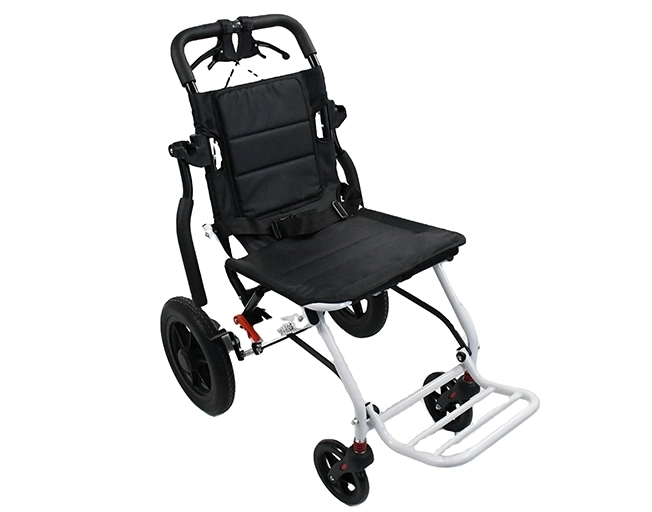The Best Lightweight and Foldable Aircraft Wheelchairs for Your Travel
Time : Sep 15, 2025 View : 1,386
Air travel can spark new adventures, but for folks who use wheelchairs, it often tosses in extra bumps. Whether you’re zooming to a family get-together or a work meeting far away, picking the right wheelchair shifts the game. In this guide, we’ll dig into why light and collapsible models shine for flights, which features you should focus on, and some great options to check out. We’ll also toss in handy tips to smooth out your journey. By the end, you’ll have a solid idea of how to grab an aircraft wheelchair that fits your life without piling on stress.

Why Lightweight and Foldable Wheelchairs Are Essential for Air Travel
Flying comes with its own set of rules and headaches that can twist a simple trip into a big hassle for wheelchair users. Airlines set tough limits on what you can bring aboard, and not every wheelchair makes the cut. Lightweight and foldable designs stand out because they handle flight needs and daily tasks with ease.
Airline Restrictions:
Most airlines cap the size and weight of items you can carry or check. For example, the Federal Aviation Administration (FAA) in the U.S. lays down clear rules. Wheelchairs must slip through cabin doors or stow neatly in cargo holds. Many airlines let manual wheelchairs ride in the cabin if they fold to under 13 inches wide. But heavier ones often end up as checked bags.
Rules change overseas, too. European airlines, like British Airways, may ask for a heads-up if your mobility aid tops 44 pounds. These aren’t just random hoops. They tie to safety, like making sure everyone can exit fast or keeping electric model batteries from sparking fires.
Challenges Users Face:
Nobody wants their wheelchair banged up during a flight, but it happens more than you’d hope. The U.S. Department of Transportation says over 10,000 mobility devices get roughed up yearly—think scratches or busted wheels. Checking your wheelchair as luggage leaves it open to rough handling by baggage crews. Fixing it can take weeks.
Then there’s the waiting game. Airport help might keep you sitting for 30 minutes or more, waiting for staff to assist with boarding, especially at busy spots like Atlanta or Heathrow. Heading to smaller towns adds more snags. Some airports skip ramps or lifts, so stairs become a hurdle. Foldable wheelchairs save the day here. They’re easier to carry or squeeze through tight spots.
Renting gear at your destination can be a pain too. Sometimes, the rented chair is too wide for hotel doors. Not every trip flops, though. Many airlines now train their staff better. Still, being ready is the name of the game. Moving from rules to features, it’s plain that top aircraft wheelchairs tackle these issues head-on, mixing easy carrying with trustworthiness.
Key Features to Consider When Choosing an Aircraft Wheelchair
Choosing the right wheelchair isn’t about snagging the cheapest one. It’s about matching details to how you travel. With tons of models out there, zeroing in on key parts like materials and design lands you a chair that’s sturdy yet ready for flights. Let’s break down what to hunt for, pulling from years of chatter in the mobility world.

-
Lightweight Materials: Weight is everything in air travel. Chairs made from carbon steel or aluminum alloys often tip the scales at under 15 kg, making them easier to lift and store. Carbon steel, for one, offers strength without bulk—think a net weight of 11kg for a full-featured model. This beats older steel frames that could weigh twice as much. Lighter chairs reduce strain on companions or airport staff during transfers. But materials affect more than weight. Surface treatments like paint protect against corrosion, handy for humid airports or beach destinations. Oxford cloth for seats adds breathability, preventing discomfort on long flights.
-
Foldable Design: A good fold should be quick and compact. Look for mechanisms that collapse in seconds, ideally to dimensions like 85×52×85cm. This size fits most airline storage rules. Airplane folding wheelchairs often prioritize narrow profiles, around 40cm seat width, to navigate aisles as slim as 17 inches on regional jets. It’s worth noting that while electric versions exist, manual folding wheelchairs dominate for simplicity, no batteries to worry about.
-
Battery Compliance: For those eyeing electric options, batteries are a big deal. FAA rules call for non-spillable batteries under 300 watt-hours. They must pop out for cabin storage. Lithium-ion ones need protective cases to avoid shorts. Miss this, and your chair might get blocked at boarding. I’ve seen it happen at security gates. Manual models skip this hassle, which is why frequent flyers love them. But if power helps with tiredness, check airline rules early. Most, like Delta, post guides online.
-
Safety and Comfort: Seat belts are essential. Sturdy PVC wheels ensure smooth rolling during bumpy rides, preventing accidents. Comfortable seating should include a padded seat, an adjustable backrest approximately 35cm high, and a seat height of approximately 50cm for easy entry and exit. Anti-tippers and brakes add peace of mind. In crowded terminals, these prevent rolls on inclines. Users often overlook ergonomics, but a well-designed chair reduces pressure sores on long hauls.
With these features in mind, the next step is seeing them in action through real recommendations. This bridges the gap between theory and practice, helping you visualize the ideal fit.
Top Recommended Lightweight and Foldable Aircraft Wheelchairs
The market’s full of choices, but a few pop for air travel. We’re focusing on manual models for their ease and rule-following, but electric options suit those needing an extra push. Electrics help with longer stretches, but batteries must match FAA rules. Models with removable packs under 160 watt-hours work best. They’re heavier, often 44-66 pounds, so plan for help. Let’s spotlight Xunyu Medical’s manual aircraft wheelchair to show its edge over electric.
Manual Folding Wheelchair: Balancing Portability and Functionality
Manual models shine for their straightforwardness. No charging needed, and they fold fast for flights. Their perks boil down to three big wins: super-light materials, quick folding, and flight-ready design.

-
Ultralight Material: Go for frames like carbon steel, keeping weight low at 11 kilograms while holding up to 110 kilograms. This stuff resists dents better than cheaper picks. Xunyu Medical’s 12-inch white model uses painted carbon steel for toughness, shipped to places like Europe and the Middle East.
-
Quick Folding Design: Xunyu’s quick-fold system stands out—collapses in under 10 seconds to 85x52x85 centimeters. Flip-up armrests and a 40-centimeter seat width make it aisle-ready. The black Oxford cloth cushion comes with a belt for safety.
-
Aircraft-Optimized Features: Xunyu Medical builds with flights in mind: slim enough for airplane aisles, with PVC wheels that roll smoothly on terminal floors. It’s a great pick for airline travel wheelchairs.
How to Ensure a Smooth Air Travel Experience with Your Wheelchair?
Preparing ahead of your trip can make things easier and smoother. From packing to maintenance, small steps will ultimately pay off.
-
Pre-Trip Preparation: Call your airline 48 hours ahead—most need it for special help. Pack backup parts like wheel tubes; a flat during a layover stinks. Measure your chair against the plane’s specs. Boeing 737s have 32-inch doors, for instance.
-
Airport Procedures: Show up early, at least two hours for domestic flights. Use fast lanes if you can. For transfers, ask for an aisle chair, but practice with your own for comfort. Security might take parts apart—label them clearly.
-
Regular Maintenance: Check brakes and wheels every month. Clean fabrics to avoid smells. Xunyu Medical products, with their solid builds, last well, but a yearly pro checkup stretches their life.
-
Alternative Options: If traveling light, think about rentals at your destination. Or try lightweight scooters for a change. But owning a flight wheelchair like Xunyu’s often feels most dependable.
Conclusion
Lightweight foldable aircraft wheelchairs turn air travel from a struggle into a chance to explore. They handle airline rules, cut risks, and boost freedom. Based on your routine—quick local trips or long-distance treks—pick a model that matches your needs, like weight limits or fold speed. Manual options, especially from trusted wheelchair manufacturers, strike the best balance for most.
As one of the best walking aid manufacturers, Xunyu Medical has worked on refining product design. Their products reach Europe, North America, the Middle East, and the Asia Pacific. They work with big online stores and healthcare suppliers, serving thousands of families and groups worldwide. You can trust Xunyu Medical completely. For tailored help, reach out to their team at paddy17727303057@outlook.com. Enjoy your trip, and may your next flight be a safe one!


